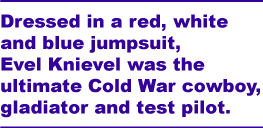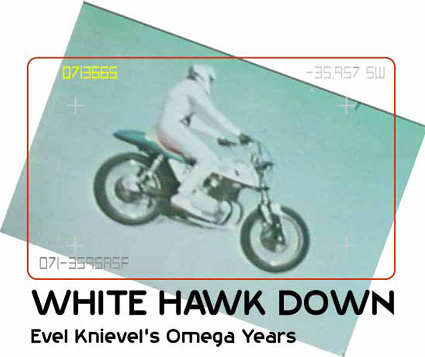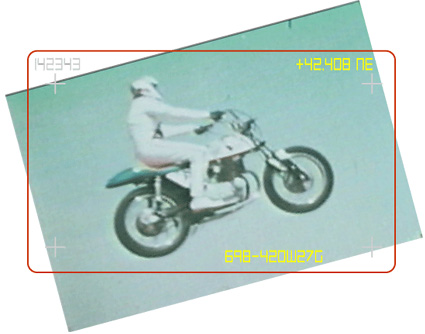 |
The last two decades of the 20th
century were not kind to Evel Knievel, the greatest daredevil
of all time. Set back by problems both physical and spiritual,
Evel sometimes walked a lonely road. His astounding legacy
all but forgotten to the public at large, Evel became
a mere shadow of himself.
Those were Evel Knievel’s lost years,
a lean and uncertain time for the original Master of
Disaster – and perhaps the darkest chapter in the
life of a man who once commanded the attention  of
millions of loyal fans the world over with his legendary
exploits: Caesar’s Palace, Cow Palace, the Snake
River Canyon jump, Wembley Stadium and many others. of
millions of loyal fans the world over with his legendary
exploits: Caesar’s Palace, Cow Palace, the Snake
River Canyon jump, Wembley Stadium and many others.
He found himself 40-something, retired,
divorced, and waist-deep in financial and medical quicksand.
Instead of commanding every American’s attention
plotting his next gravity-defying spectacle, Evel took
his prescriptions from Dr. Jack Daniels and gamely made
the auto-show rounds, occasionally popping up on late
night television as a pitchman for roadside hotel chains,
hawking 1-800 products like “The Stimulator”
(static electricity arthritis buster) and, as this reporter
can testify to personally viewing on television, hoisting
himself 100 feet up in the air in a crane-suspended
trailer-home as a gimmick to sell Dodge automobiles
to the denizens of Central Oklahoma.
It was not always this way.
As anyone who grew up during the 1970s
knows, Evel Knievel was a Man of Action, and one of
the definitive icons of that time. Charismatic, larger
than life, with a patriotic streak as long as his medical
chart, Evel Knievel’s public persona presented
a stark contrast to the growing cynicism, the drugged
up hedonism, the distrust of men in uniform that was
common in the ambiguous landscape of that hazy, burned
out decade.
Here was a man who seemingly hailed straight
from Mythic America. Like the Lone Ranger, Evel was
sometimes misunderstood as an outlaw. Yet at every turn
his good intentions and dashing charm quickly convinced
city and country folk alike to embrace his heroic calling.
Dressed in a red, white and blue jumpsuit,
Evel Knievel was the ultimate Cold War cowboy, gladiator
and test pilot. There was nothing he liked better than
to ride into town on a Harley-Davidson motorbike to
remind the American people that there was still plenty
of action left in this great nation of ours. For a time,
a star-struck generation embraced him, and he was their
champion.
But times change. As the 1970s faded into
history, so did Evel Knievel. Gone was the cool merchandise
like the durable line of zip cord or crank-driven toys
bearing his coat of arms. Gone were the appearances
in high-rated  television
shows like “The Bionic Woman” and in the movies.
And gone too was Howard Cosell, whose supremely captivating
reporting style focused the attention of 1970s America
onto guys like Evel Knievel (and his counterpart, the
equally boisterous and quotable Muhammad Ali) with all
the intensity of the Death Star’s planet-destroying
laser. Indeed, given the vanilla fudge superpowers of
Ali and the Evel One, people in the 1970s had good reason
to question whether Kal-El, also known as Superman,
really was the sole survivor from the faraway, doomed
planet of Krypton. television
shows like “The Bionic Woman” and in the movies.
And gone too was Howard Cosell, whose supremely captivating
reporting style focused the attention of 1970s America
onto guys like Evel Knievel (and his counterpart, the
equally boisterous and quotable Muhammad Ali) with all
the intensity of the Death Star’s planet-destroying
laser. Indeed, given the vanilla fudge superpowers of
Ali and the Evel One, people in the 1970s had good reason
to question whether Kal-El, also known as Superman,
really was the sole survivor from the faraway, doomed
planet of Krypton.
Perhaps the nation simply outgrew Evel:
in a time of countless front page scandals, the collapse
of the Soviet Union, and the insidious rise of Political
Correctness, there just didn’t seem to be anyplace
left on the public stage for a simple guy from Montana
who sincerely loved his country, didn’t take drugs,
and wanted to make people happy by achieving low-earth
orbit on a motorcycle.
It seemed that the greatest daredevil
of all time would soon be little more than a footnote
in psychiatric textbooks or a punch-line on the quiz
shows: a crazy, self-instructed country boy whose appetite
for breaking the rules of common sense and the laws
of gravity just didn’t jibe with the cell phone-toting
New Squares of the ‘80s and ‘90s.
But even in his darkest hours – when
he was using a walker due to his deteriorating hip,
when his own son Robbie was threatening to eclipse him
in the record books, when he was sent up the river to
the state pen for breaking the arms of a writer who
wrote a lengthy profile about his darkest hours –
even then, not everyone forgot about Evel Knievel. His
loyal fans were, and still are to this day, legion.
When he announced his comeback at Galpin Ford on June
1st, when he vowed that his last jump would be the greatest,
most spectacular one of them all – on that day
the Legion of Evel was reborn.
If the last two decades have been a forced
march through Death Valley for the greatest daredevil
of all time, then his uncanny revival must be the Promised
Land. Thanks to the modern miracle of medical science,
Evel’s back and better than he was before. This
reporter wishes him nothing but the best of luck in
his latest, greatest jump.
Evel, there’s only one man in the
world who can do what you can. It’s good to have
you back.
Mick Garrett, Hollywood Five-O 
|
 |




 of
millions of loyal fans the world over with his legendary
exploits: Caesar’s Palace, Cow Palace, the Snake
River Canyon jump, Wembley Stadium and many others.
of
millions of loyal fans the world over with his legendary
exploits: Caesar’s Palace, Cow Palace, the Snake
River Canyon jump, Wembley Stadium and many others. television
shows like “The Bionic Woman” and in the movies.
And gone too was Howard Cosell, whose supremely captivating
reporting style focused the attention of 1970s America
onto guys like Evel Knievel (and his counterpart, the
equally boisterous and quotable Muhammad Ali) with all
the intensity of the Death Star’s planet-destroying
laser. Indeed, given the vanilla fudge superpowers of
Ali and the Evel One, people in the 1970s had good reason
to question whether Kal-El, also known as Superman,
really was the sole survivor from the faraway, doomed
planet of Krypton.
television
shows like “The Bionic Woman” and in the movies.
And gone too was Howard Cosell, whose supremely captivating
reporting style focused the attention of 1970s America
onto guys like Evel Knievel (and his counterpart, the
equally boisterous and quotable Muhammad Ali) with all
the intensity of the Death Star’s planet-destroying
laser. Indeed, given the vanilla fudge superpowers of
Ali and the Evel One, people in the 1970s had good reason
to question whether Kal-El, also known as Superman,
really was the sole survivor from the faraway, doomed
planet of Krypton. 
